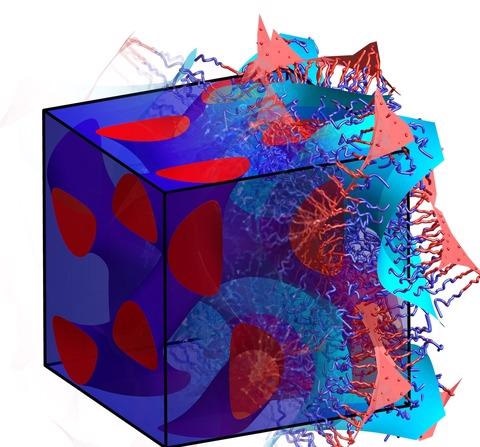Polymer scientists from the University of Massachusetts Amherst recently published a paper in Nature Communications that answered a longstanding mystery about a nanoscale structure called a double-gyroid, made up of groupings of molecules.
 In a double-gyroid, two materials (here pictured as red and blue) thoroughly interpenetrate each other. Image Credit: Reddy et al., 10.1038/s41467-022-30343-2.
In a double-gyroid, two materials (here pictured as red and blue) thoroughly interpenetrate each other. Image Credit: Reddy et al., 10.1038/s41467-022-30343-2.
This shape is one of the most prized for materials scientists, and it has a wide variety of uses; nevertheless, researchers have been unable to anticipate how these forms arise until now.
There is a beautiful interplay between pure mathematics and materials science. Our work investigates how materials self-assemble into natural forms.
Greg Grason, Senior Author and Professor, Polymer Science and Engineering, University of Massachusetts Amherst
These forms can take many different forms. They can be basic shapes such as a layer, cylinder or sphere.
A bit like soap films. There is an intuitive understanding of the shapes that molecules, such as those in soap, can build. What we have done is to reveal the hidden geometry that allows polymers to assume the double-gyroid form.
Michael Dimitriyev, Co-author and Postdoctoral Researcher, Polymer Science and Engineering, University of Massachusetts Amherst
What does a double-gyroid actually look like? It is not intuitive.
They are something in between a layer and a cylinder.
Abhiram Reddy, Lead Author and Postdoctoral Researcher, Northwestern University
In other words, envision a flat piece of window screen, or a layer, and then twist it up into a saddle-shaped layer that fits within a cubic box with the smallest possible surface area. This is a gyroid. When a second material, likewise twisted into a gyroid, fills the gaps in the first gyroid, it is called a double-gyroid.
Each gyroidal substance generates a network of tubes that are interconnected. They combine to produce an incredibly complex substance that is symmetrical on all sides, like many crystals. It is also penetrated by labyrinthine passageways made up of diverse chemical components. As it is a hybrid of two gyroids, this material could exhibit conflicting characteristics.
These double-gyroids have long been observed in nature, but no one has worked out how chain molecules, termed block copolymers, produce double-gyroids.
Reddy and his co-authors expanded on a prior theoretical model by incorporating thermodynamics and the medial map, a new approach to thinking about the packing issue (or how best to fill a limited container with material) drawn from computational geometry.
Since copolymers must stretch to fill every area of the self-assembled structure, understanding its creation necessitates understanding how molecules “measure the center” of forms vastly more complicated than spheres and cylinders.
The team’s revised theoretical model not only explains the perplexing formation of double-gyroids but also holds promise for understanding how the packing problem works in a much broader range of self-assembled superstructures, such as double-diamonds and double-primitives, as well as structures yet to be discovered.
The researchers, who were funded by the US Department of Energy, now intend to work with synthetic chemists to start improving their hypothesis using experimental evidence.
The ultimate objective is to create a wide range of materials that take advantage of the double-gyroid’s structure and can assist in developing technologies ranging from rechargeable batteries to light-reflective coatings.
Journal Reference:
Reddy, A., et al. (2022) Medial packing and elastic asymmetry stabilize the double-gyroid in block copolymers. Nat Commun doi:10.1038/s41467-022-30343-2.